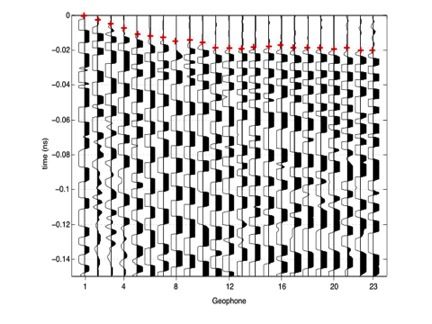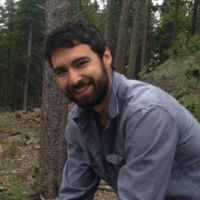Geophysics, Hydrology: Aspect controls on seismic anisotropy and groundwater flow paths: Aaron Bandler Research Group
My research explores the ability of hillslopes in Gordon Gulch to transmit water. Water typically moves through porous matrices and/or fractures in rock, and hypotheses suggest that the north- and south-facing slopes of Gordon Gulch have different subsurface architecture and different hydraulic conductivities. We use boreholes to examine fracturing in bedrock and saprolite, and seismic refraction to assess whether there is directional dependence of fractures. Using these data, we can compare the characteristics of fracturing (i.e. strike, dip, frequency, aperture), the degree of weathering, and the depth to geologic contacts.
Image: Seismic wave sources are triggered by a sledgehammer struck against the ground.
This group is tagged with:
-
Groundwater flow is a driver of important chemical and geological processes. The flux of water through soil and rock influences the rate at which nutrients such as nitrogen cycle through the system, and the rates of physical and chemical weathering of geologic material. My research compares the ability of two opposing hillslopes to transmit water. In snow-dominated watersheds such as Gordon Gulch, north-facing slopes retain snowpack throughout the winter season and exhibit an intense hydrologic flux during spring melt. By contrast, snowpack on south-facing slopes typically melts shortly after accumulation due to more incoming solar radiation. These are observations from Hinckley et al. (2014), who also suggest that differences in slope aspect drive subsurface characteristics such as the rate of weathering. We drilled 7 boreholes across both aspects of Gordon Gulch and examined the orientation and density of fracturing on each hillslope. We also conducted multiple seismic refraction surveys on each slope, wherein we collected data from transects that overlapped in an asterisk type pattern, in order to assess whether the velocity of subsurface media depends on direction. From borehole data, we found that both the north- and south-facing slopes have a dominant east-west fracture direction. The seismic refraction data corroborate these borehole observations, such that seismic velocity tends to be faster when propagating tangentially to fractures, and slower when propagating normal to fractures. Seismic data allow us to delineate the depths to geologic contacts, and we identify that on both slopes, the depth to saprolite is approximately 2 m, and the depth to bedrock is approximately 9 m. Additionally, we found that south-facing slopes have much faster velocities in the saprolite than north-facing slopes. Our results suggest that north-facing saprolite is more highly weathered, but that the depth to unweathered bedrock is approximately equal on both slopes. These results support previous hydrological research in Gordon Gulch, which suggests that water moves through a connected pore matrix on north-facing slopes, and preferentially through fractures on south-facing slopes.
First arrivals of seismic waves (red crosses) at 23 geophones. Seismic source is at geophone 1. A change in slope of red crosses at geophone 8 indicates a subsurface velocity contrast.
Publications/Presentations:
Hendricks, S., Singha, K., Bandler, A. “Assessing Aspect Control on Adjacent Weathering Hillslopes Using Seismic Anisotropy Velocity Models within the Boulder Creek Critical Zone Observatory, Colorado.” The Geological Society of America 2015 Annual Meeting. Baltimore, MD. 4 November 2015. Poster.Bandler, A., Magill, R.C., Hendricks, S., Singha, K. “Aspect Controls on Bedrock Fracturing and Seismic Velocity within the Boulder Creek Critical Zone Observatory.” American Geophysical Union Fall Meeting. San Francisco, CA. 18 December 2015. Oral Presentation.
First arrivals of seismic waves (red crosses) at 23 geophones. Seismic source is at geophone 1. A change in slope of red crosses at geophone 8 indicates a subsurface velocity contrast.
-
Contacts
Alumni-Former
GRAD STUDENT
.(JavaScript must be enabled to view this email address)
Geophysics, Hydrology
Explore Further



